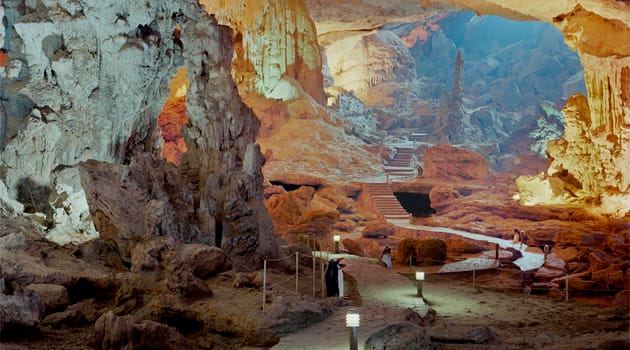Show Caves
Exploring the appeal of “show caves” around the world, from their breathtaking natural beauty to the variety of tourist grotesqueries.

Interview by Nozlee Samadzadeh
TMN: Why caves?
Austin Irving: The project came about very organically. In 2008 and again in 2009 I had an amazing opportunity to travel throughout Southeast Asia with my large format camera. I am extremely inspired by that part of the world: the architecture, the plant life, the tourist attractions. When I got back to the States and started scanning and organizing all my negatives, I realized that I had been attracted to and photographed a lot of caves. I then became interested in this idea of a “show cave.” These are natural caves managed by government or commercial organizations that have been modified to accommodate tourism. Continue reading ↓
All images used with permission, © copyright the artist, all rights reserved.











Interview continued
Next I started to wonder how American show caves compared to the ones that I had visited and photographed in Viet Nam, Singapore, Malaysia, and Thailand. Since returning from Southeast Asia, I have been intentionally seeking out caves to shoot. The caves I focus on have been modified to accommodate tourism—if the hand of man is present, I will for sure have something to photograph.
What’s so awesome about American caves is that there are so many of them! Each state has at least three or four caves to visit; truck stops, information stations at motels, and camp sites all have pamphlets boasting about some incredible cave that you have to see. “Come see the Cave of Wonders!” “Don’t miss the Endless Caverns!” I’ve done a lot of research and have a long list of caves I still need to photograph. I’m thinking Kentucky is next on my list. I’ve heard that there is a really weird underground picnic area in Mammoth Cave that I’m really going to need to get.
TMN: Describe a typical photo shoot.
Austin Irving: While my photographic intentions stay consistent from cave to cave, each location is unique both in its natural formations and the tourism additions—and each photographic experience greatly differs from country to country. In the caves that I visited in Southeast Asia, I didn’t have to be part of a guided tour, meaning that I could roam around with my large format camera and take as many 25-minute exposures as I wanted—a dream come true! I think their motto was if you get hurt, it’s your fault, whereas in America, all the show caves that I want to photograph are run by commercial organizations that require insurance, as they could be sued if one of their patrons got injured straying from the mandatory guided tour.
So in the first few American caves, I was often pressed for time—nobody wants to be that one person on the tour holding everyone up because they are taking a 15-minute exposure of a recycling bin next to a stalactite with a 4x5 camera! I learned the hard way that I needed to call in advance to get permission from the owners to have a guide accompany me during my shoots.
TMN: How did man-made touches enhance or take away from the natural beauty of these caves?
Austin Irving: What excites me the most about these locations is how these man-made touches are equal parts beautiful and grotesque. Some of these additions could be viewed as acts of vandalism, but on the other hand I wouldn’t even be able to photograph or explore these incredible caverns without the added lighting, pathways, elevators, etc. It’s this contrast, the tension that exists between these slow-forming geological anomalies and our augmentations that fascinates me and inspires me to continue this project.
TMN: Which is your favorite cave?
Austin Irving: The hardest question! This is so difficult to answer because each cave is so cool and extremely different from the next. I am going to say Carlsbad Caverns because it was a cave that I visited first as a child and has clearly stuck in my mind for many years. I am also partial to it because in 2010 I made Carlsbad Caverns Elevator Room, N.M., the fourth image in the slideshow, which at the moment serves at my thesis statement for this project.
TMN: What does it say about us as humans that visiting caves is a popular act of tourism?
Austin Irving: One of the most fascinating aspects of show caves is the universal way in which these natural locations are modified to encourage tourism. Aside from signage in different languages, there are no real cultural signifiers to indicate any specific country. An underground tshirt stand in Viet Nam could just as easily be in New Mexico! There is this shared fantasy of what a cave should look like, which I’ve noticed is best exemplified in the ubiquitously garish lighting choices.
I often think about our species’ long relationship with caves: a place of safety, ritual, quiet, fear, etc. We must have spent a lot of time in caves and I am interested in the notion that those experiences might have burned themselves into our collective unconscious. I definitely have a visceral feeling while being inside and marveling at these natural wonders. It’s a pleasant reminder of my own insignificance and I can’t help thinking that it’s something that everyone feels to some degree—after all, there are hundreds of show caves to visit all over the world.
